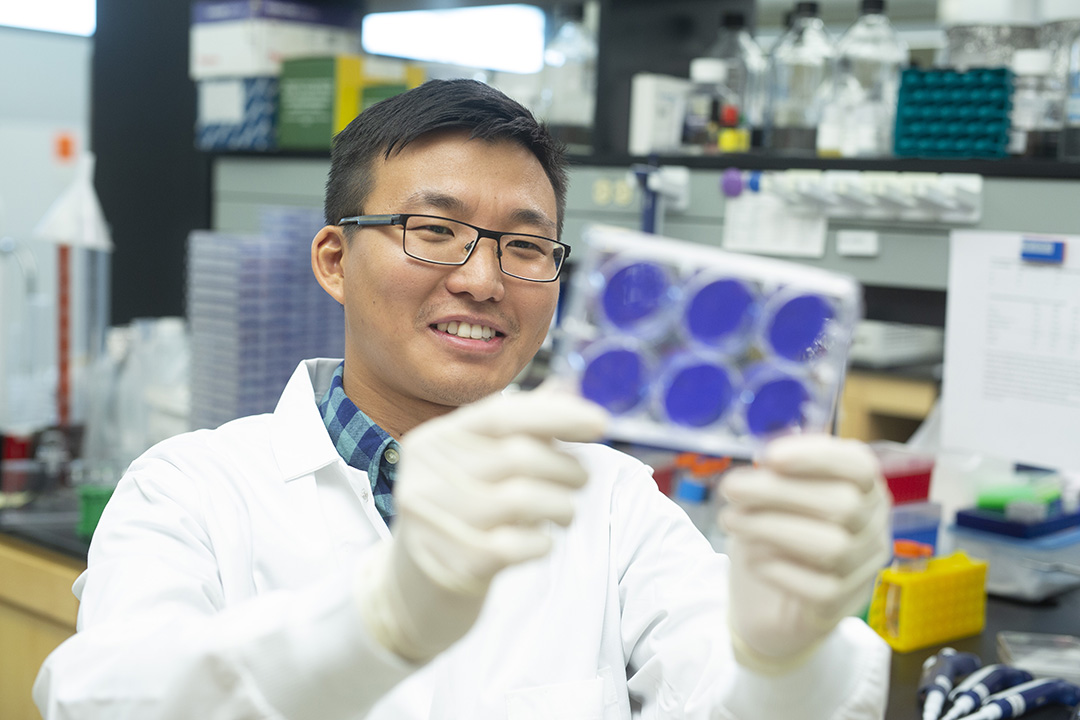
Innovative research finds influenza detection system in body
University of Saskatchewan researchers have found a unique “sensor” mechanism inside cells that enables the immune system to recognize influenza, a finding that may lead to improved vaccines in the future.
By Federica Giannelli“We have solved a long-standing puzzle as to how the body detects influenza A,” said PhD student GuanQun Liu, who is doing his research at the university’s Vaccine and Infectious Disease Organization — International Vaccine Centre (VIDO-InterVac).
In results published today in Nature Communications, Liu and his supervisor Yan Zhou identified for the first time that a protein sensor, a “patrolling” system for detecting influenza A, is the first line of defence against the virus in the nucleus of cells.
This year marks the centennial of the deadly 1918 influenza pandemic that killed more than 50 million people around the world. But influenza A, the most severe flu virus that can affect both humans and animals, continues to pose a health threat today as it did back then.
“Our goal is to find better ways to control flu infections around the world,” said Liu. “These viruses seem undefeatable in the history of medicine due to their high genetic variability that causes a resistance to antiviral agents.”
Called retinoic acid-inducible gene I (RIG-I), the newly defined sensor “lives” inside the cell nucleus and not exclusively in the cytoplasm, as had been previously thought. The cytoplasm is a gel-like substance surrounding the nucleus and other cell structures.
Unlike most other RNA viruses that replicate in the cytoplasm, influenza A replicates in the nucleus. Zhou and Liu determined that upon detecting the virus in the nucleus, RIG-I works together with its counterpart in the cytoplasm to trigger the body’s immune response.
“Our study has provided a new rationale that paves the way for developing innovative influenza vaccines and antiviral therapeutics one day,” said Zhou, VIDO-InterVac research scientist.
Applications may include drugs that enhance RIG-I’s ability to detect influenza. While everyone has RIG-I in their body, a person’s health conditions or genetics may hinder how RIG-I works with the immune system to respond to influenza infections.
To detect RIG-I in the nucleus of cells and study its function, Zhou and Liu have developed cell lines in the lab and infected them with influenza A virus. They relied on the state-of-art containment facilities at VIDO-InterVac, a world-class institute for infectious diseases and vaccine research.

“The aim of VIDO-InterVac’s research is to protect human and animal health,” said VIDO-InterVac director and CEO Andrew Potter. “Knowing how influenza viruses are recognized by our immune system is a critical step in determining new and better targets for future vaccines and antivirals.”
The researchers caution more research is needed before a vaccine is developed and they plan to continue studying how RIG-I works in the body.
“We want to understand the specific role that RIG-I plays in the nucleus and what it does in the cytoplasm of cells,” said Zhou, also an adjunct professor in the College of Western Veterinary Medicine and in the School of Public Health. “We need to understand how our natural defence system works to develop vaccines.”
Originally from China, Liu came to the U of S in 2010 thanks to an exchange program under a flagship partnership between the U of S and the Beijing Institute of Technology and decided to stay for his PhD studies.
“This experience provided me with the opportunity to work with researchers who are international leaders in their field,” he said.
The research in Zhou’s lab is supported by the federal agency NSERC, the Public Health Agency of Canada, and the Agriculture Development Fund from the Saskatchewan Ministry of Agriculture.
Federica Giannelli is a graduate student intern in the University of Saskatchewan research profile and impact unit. This content runs through a partnership with The StarPhoenix.
This article first ran as part of the 2018 Young Innovators series, an initiative of the U of S Research Profile and Impact office in partnership with the Saskatoon StarPhoenix.

